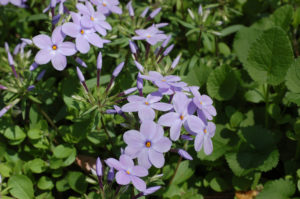In areas where I am trying to grow ground covers that self-spread, I haven’t been using mulch, thinking the mulch will hinder the self-spread of the desired ground cover. Thus weeds and other things I didn’t want to grow in that space do fill in. Is it recommended to use mulch even when the ultimate goal is to have the ground covered with plants? Mulch will save me a lot of my weeding time.
Terrific question! Using mulch to discourage weeds while waiting for a spreading groundcover to fill in is a great idea – it is the sort of thing that mulch is ideal for. Mulch is good at inhibiting weeds seeds from germinating and will surely make your life easier. Make sure that your mulch isn’t put on too thick (1 or 2” is fine) so that your ground cover will be able to spread unhindered. As time goes on, you will be able to use less and less mulch.
Having said all that, I am assuming that you are asking about a groundcover that is spreading vegetatively by creeping aboveground or spreading underground by rhizomes. If you are also counting on your ground cover spreading by seed, remember – mulch will discourage both weed seeds and wildflower seeds from sprouting.
~ Dr. Randi Eckel, Toadshade Wildflower Farm, NJ

Creeping phlox( Phlox stolonifera )is an excellent ground cover.
Yes, I recommend using mulch the first season when establishing a groundcover. It will help to suppress the weeds while the ground cover fills in.
If it is a groundcover that spreads by stolons or above-ground stems, then I would go a bit lighter on the layer of mulch. If it’s a groundcover that spreads by underground rhizomes, the mulch shouldn’t suppress the spread.
~ Missy Fabel, Landscape Designer, NY
There are a couple of ways to solve the problem of weed pressure as your plants get established after planting, regardless of whether they are ground covers or other types of landscape plantings. Do use mulch in the first few years before the space is filled in by plants. The best mulch would be an aged or shredded leaf mulch or aged bark mulch. Use it between the new plants while there is still space between them. Apply it generously in spring. This won’t hinder the ability of the groundcovers to knit together. Groundcovers like foamflower, creeping phlox, and wild strawberry that spread by stolons (above ground runners) will benefit from the extra organic matter from the mulch as well. You do want to go easy on mulch with self-sowers like asters or partridge pea since their seeds need to make contact with open soil to germinate. The other important way to keep weeds at a minimum when establishing a groundcover is to place plants close together (12″ or less). You can do this by purchasing landscape plugs and planting them say, 6-10″ apart. They will knit together faster and allow less space for weeds to come through.
~Anna Fialkoff, Program Manager Wild Seed Project, Maine
***
Each author appearing herein retains original copyright. Right to reproduce or disseminate all material herein, including to Columbia University Library’s CAUSEWAY Project, is otherwise reserved by ELA. Please contact ELA for permission to reprint.
Mention of products is not intended to constitute endorsement. Opinions expressed in this newsletter article do not necessarily represent those of ELA’s directors, staff, or members.

